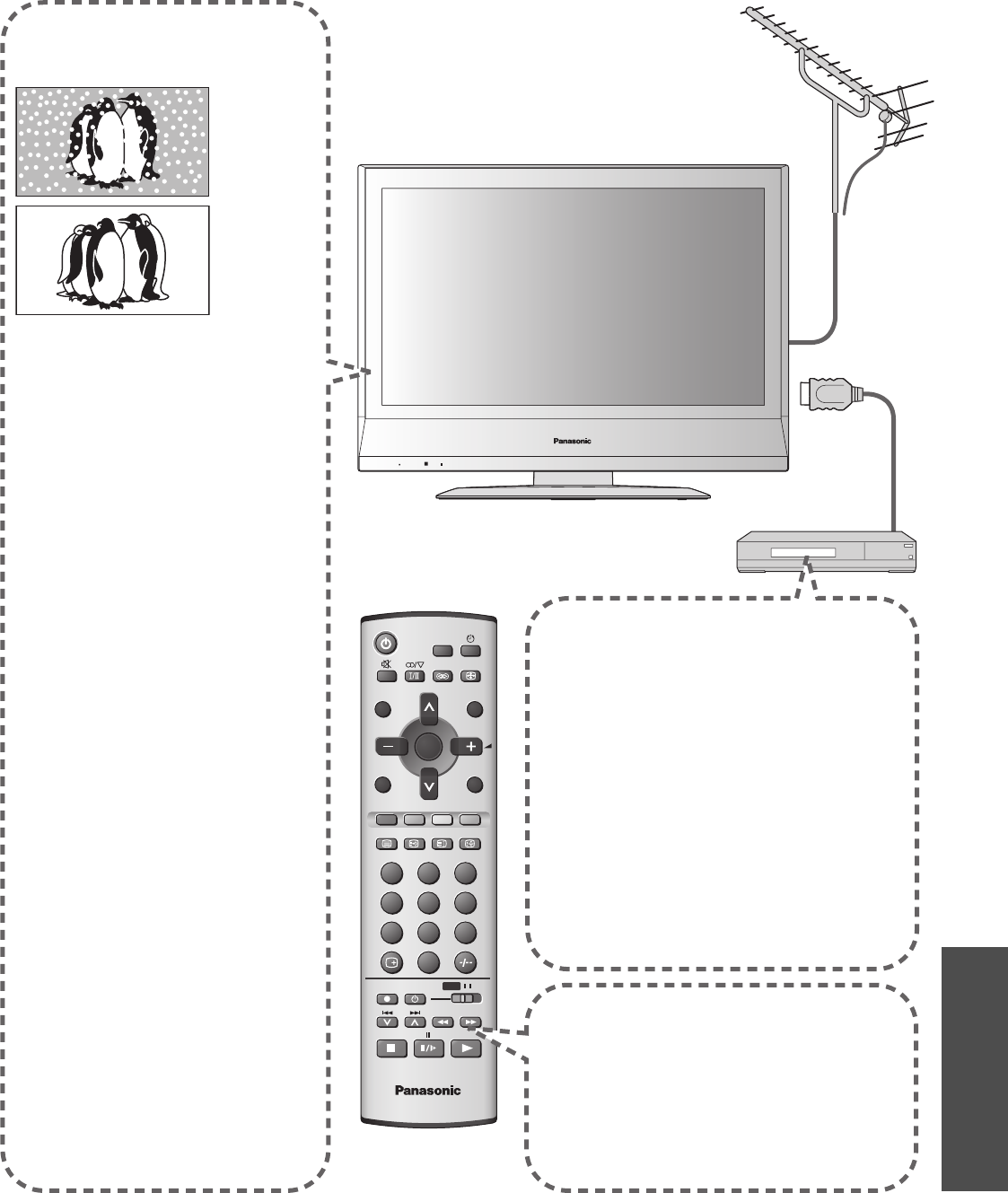
FAQs, etc.
1 2 3
4 5 6
7 8 9
0
TV
VCR DVD
MENU
REC
TV/AV
N
R-TUNE
OK
ASPECT
SURROUND
F.P. INDEX
TV/TEXT
HOLD
STILL
26
27
Technical Information
Input signal that can be displayed
∗
Mark: Applicable input signal for Component (Y, PB/CB, PR/CR) and HDMI
Note
•
Signals other than above may not be displayed properly.
•
The above signals are reformatted for optimal viewing on your display.
•
Frequently Asked Questions
•
Technical Information
Stereo / Bilingual Sound Selection
Control with HDMI
•
Setup the equipment to enable this function. Read the manual of the equipment.
•
Switch the TV unit on again with the equipment on when connection or setup is changed.
•
This function may not work normally depending on the equipment condition.
•
The equipment can be operated by TV’s remote control with this function on even if TV is in Standby mode.
•
Image or sound may not be available for the fi rst few seconds when the playback starts.
•
Image or sound may not be available for the fi rst few seconds when Input mode is switched.
HDMI connections to some Panasonic equipments allow you to enjoy the easy playback or home theatre.
Note
•
If the stereo signal is poor or the receiving conditions are not optimum or if STEREO:MONO automatic switching
occurs, it is recommended you switch from STEREO to MONO.
•
Even when the contents of the receiving signal undergo changes, selection mode is kept intact.
•
When the receiving conditions deteriorate, listening will be easier if the mode is set to the MONO position, using
the stereo / bilingual sound selection button.
•
DUAL, also known as DUAL MONO or as BILINGUAL is not currently transmitted in some countries.
FAQs
Before requesting service or assistance, please follow these simple guides to resolve the problem.
If problem still persists, please contact your local Panasonic dealer or Panasonic Customer Care Centre
for assistance.
White spots or shadow
images (noise)
•
Check the position, direction,
and connection of the aerial.
Operating temperature
•
The LCD TV radiates heat and
some sections may become warm.
This is not a problem for
performance or quality.
Ensure TV is correctly installed as
detailed on page 5.
There may be red spots,
blue spots, green spots and
black spots on the screen.
[Pixel Statement (LCD)]
•
An image on an LCD panel is
created by many dots known as
pixels. The more pixels on the
panel, the more detailed image can
be displayed. To create a colour
image each pixel is made up of
three tiny coloured dots (1 each of
red, green and blue). This gives
a total far in excess of one million
individual dots manufactured
into the panel. Each one of three
dots is precisely controlled by the
electronics of the TV to produce
the picture.
•
Whilst Panasonic maintains the
highest standards in manufacturing
technology and processes in the
construction of these panels,
there are a number of allowable
Pixel/Dot failures that would still
allow the panel to be defi ned as
a good panel. It is not possible to
guarantee absolutely no pixel loss.
Pictures from an
equipment are unusual
when the equipment is
connected via HDMI
•
Is the HDMI cable connected properly?
(p. 22)
•
Turn Off the TV unit and equipment,
then turn them On again.
•
Check an input signal from the equipment.
(p. 26)
•
Use an equipment compliant with
EIA/CEA-861/861B.
•
Using DVI connection, see page 23.
The remote control
does not work
•
Are the batteries installed correctly?
(p. 6)
•
Has the TV unit been switched On?
•
Has the battery run down?
Signal name Horizontal frequency (kHz) Vertical frequency (Hz) Component HDMI
480i(525)/60Hz 15.73 59.94
∗∗
480p(525)/60Hz 31.47 59.94
∗∗
576i(625)/50Hz 15.63 50.00
∗∗
576p(625)/50Hz 31.25 50.00
∗∗
720p(750)/60Hz 45.00 60.00
∗∗
720p(750)/50Hz 37.50 50.00
∗∗
1080i(1125)/60Hz 33.75 60.00
∗∗
1080i(1125)/50Hz 28.13 50.00
∗∗
When you receive the stereo / bilingual sound system, sound output modes can be selected by pressing
the Stereo / Bilingual Sound Selection button.
Audio Signal STEREO
MAIN
I
SUB
II
MONO
Mode Indicator
I II
NICAM .......Used in New Zealand, Singapore, Hong Kong etc.
Type of broadcast
Regular broadcast
(Standard Audio)
Regular + NICAM MONO
I
(MAIN
I
)
NICAM STEREO
NICAM DUAL MONO
(MAIN
I
/ SUB
II
)
Mode Indicator
No Indicator
I
I
II
A2 (German) .......Used in Australia, Malaysia etc.
Type of broadcast
Regular broadcast
(Standard Audio)
BILINGUAL or DUAL MONO:
MAIN
I
/ SUB
II
STEREO
Mode Indicator
No Indicator
III


















